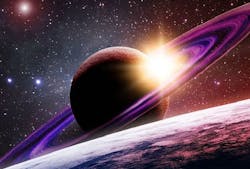Television and movies can be educational, but they can also mislead. Take a look at these myths about outer space. Odds are, you heard about them first from TV or a movie.
Myth #1: Meteorites are hot. Many people would think it unwise to pick up a meteorite that had just landed on Earth. It would be too hot, they reason. But meteorites have been in space for billions of years, which is a cold environment, just a few degrees above absolute zero. So when they land, they are lukewarm at most.
But don’t they fall to Earth in flames? Not really. The fireball is actually the air in front of the meteorite being compressed at high speeds and heated until it catches fire. This does heat the outer layers of the “falling star,” but that layer is blown off on impact with the Earth.
Myth #2: Go into space without protection and your blood will instantly boil, and then you will explode. Popular media says humans are pressurized internally and if they are exposed to the extreme low pressure/vacuum of space, the internal pressure will make the human body explode. But outer space’s extremely low pressure will first lower the boiling point of all liquids, including blood, and it will boil right out of your arteries and veins. Sounds grim. But there’s hope, sort of.
Skin, a human‘s largest organ, does such a good job at protecting and containing our internal organs, muscles, and bones that the human body can resist explosive decompression. And the circulatory system adapts to new environments quickly, even outer space, letting it continue to provide blood flow instead of just letting the blood boil off immediately.
A human wouldn‘t even freeze to death instantly either, despite the coldness of space. There’s not much in space to absorb a body’s heat, so freezing would take some time. So if you ever found yourself cast into space without a spacesuit, you would suffocate from lack of oxygen long before you froze to death.
Myth #3: One side of the moon is permanently in the dark. The dark side of the Moon got its name by never facing Earth, sort of a trick of celestial motion. Therefore, humans never saw the “dark” side until the Russians shot a satellite around to take a look. In fact, the Sun shines equally on all sides of the Moon as it rotates and orbits the Earth.
Myth #4: Asteroid belts are dangerous to interplanetary travel. There are about half a million asteroids in the Asteroid Belt, so you might think flying through it must present great risks. Not really. When NASA sent a space probe through the Belt, the agency calculated that the odds of the probe colliding with an asteroid were one in a billion.
In the far distant past, there were 1,000 times more asteroids in the Belt. But even then, the odds of that space probe hitting one would still be only one in a million. Over time, asteroids hit each other and went off into the solar system, slowly depopulating the Asteroid Belt.
Myth #5: Black holes will suck everything up. If the sun instantly transformed into a black hole tonight, we wouldn’t wake up falling ever quickly into its deadly maw. We would eventually freeze to death, but that’s not the great (but unfounded) fear with black holes.
Black holes must obey other laws of physics, and the gravitational power of the sun would be the same if it were somehow turned into black hole. Black holes have finite mass and, therefore, finite gravitational force. No one knows for sure what happens to items pulled into black holes, but we do know black holes do not possess super gravity.
Myth 6: The sun is yellow. Ask a school kid to draw a picture of the sun, and chances are you will get a yellow circle. It’s even classified as a yellow dwarf. But the sun isn’t yellow, according to NASA. Its temperature is 6,000°K, which makes it white. And seen from outside our atmosphere, the sun does look like a bright white marble.
About the Author
Stephen Mraz Blog
Senior Editor
Steve serves as Senior Editor of Machine Design. He has 23 years of service and has a B.S. Biomedical Engineering from CWRU. Steve was a E-2C Hawkeye Naval Flight Officer in the U.S. Navy. He is currently responsible for areas such as aerospace, defense, and medical.
